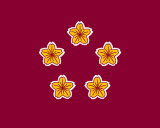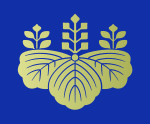Minister of Defense (Japan)
| Minister of Defense of Japan | |
|---|---|
|
Standard of the Minister of Defence | |
| Ministry of Defense | |
| Style | Her Excellency |
| Member of | Cabinet |
| Reports to | The Prime Minister |
| Appointer | The Prime Minister |
| Term length | No fixed term |
| Inaugural holder | Fumio Kyuma |
| Formation | 9 January 2007 |
| Deputy | Vice Minister of Defense |
| Website | www.mod.go.jp |
The Minister of Defense (防衛大臣 Bōei Daijin), or Bōei-shō (防衛相), is the Cabinet of Japan member in charge of the Ministry of Defense, known as the Defense Agency before 2007. The current Japanese Minister of Defense is Tomomi Inada.
On 26 December 2007, the government of Japan made the decision to upgrade its Defense Agency to the "Ministry of Defense" in the expectation to have a far-reaching effect on Japan's future military development. The defense policy that has been pursued by Japan is based on the "Basic Policy for National Defense", which was adopted by the Cabinet in May 1957. Japan's main goal of national defense is the prevention of indirect as well as direct aggression from outside enemies.
History
The Japanese government made the upgrade from the Defense Agency to the Ministry with a ceremony that was attended by then Prime Minister Shinzō Abe and the new Defense Minister Fumio Kyuma. The creation of a Defense Minister was in conjunction with Prime Minister Abe’s continued efforts to ensure a stronger image of the Japanese military. The bill in which to upgrade the Defense Agency to the Defense Ministry was approved by the Lower House in November 2007 and the Upper House in mid-December 2007. In the light of Defense Agency being transformed into the Ministry of Defense, the Self-Defense Force (SDF) was given the responsibilities of international operations, disaster relief and peacekeeping within the overseas locations.
Defense Industry
In July 1970, Director General of the Defense Agency Yasuhiro Nakasone established five directives for the defense industry:
1. Maintaining the industry base for national security for Japan. 2. To obtain equipment from Japan’s domestic development, production and research efforts. 3. To use the civilian sector for the production of arms domestically. 4. To set long-term goals for production, development, and research. 5. Become competitive in the defense production field.
By the late 1970s, Japan had received suppliers who developed and began production on a range of modernized equipment including artillery, tanks, aircraft, and major surface and underwater naval combatants. In the late 1980s efforts had been implemented to facilitate an efficient command policy, which would be able to be implemented, in the event of a crisis. The government of Japan had maintained the main principles that their military action would only be authorized by the hand of the civilians.
In October 1985, the Defense Agency began the consideration of three development options for the FSX; adoption of a foreign model, keeping an existing model, or domestic development. The agency had initially leaned towards the domestic development, however, in late 1986, the United States persuaded them to create a co-production agreement.
In October 1987, the US and Japanese officials met and decided on a joint project to remodel the F-15.
Chain of command
- 1. Prime Minister
- 2. Minister of Defense
- 3. Chief of Staff, Joint Staff
- 4. Chief of Staff of the JGSDF
- 5. Chief of Staff of the JMSDF
- 6. Chief of Staff of the JASDF
Structure
The Supreme Commander of the Japan Self-Defense Forces (JSDF), who does not formally constitute a uniformed military, is the Prime Minister. The Emperor of Japan is a constitutional monarch who does not have political or military authority over the JSDF; that authority rests with the Prime Minister. However, it is important to note that the Emperor formally appoints the Prime Minister to office. The Minister of Defense is responsible for the organization and formulating the national security policy. The budget request is drafted by the Ministry of Finance and making its own legislative proposals to the National Diet.
The Minister of Defense is advised on every concern related to the duties of the Japan Self-Defense Force by the Chief of Staff, Joint Staff.
Ministers of Defense
Liberal Democratic
Democratic
Independent
| Minister of Defense | Term of office | Prime Minister | ||||||
|---|---|---|---|---|---|---|---|---|
| # | Portrait | Name | Took Office | Left Office | Days | |||
| 1 |  |
Fumio Kyuma | January 9, 2007 | July 4, 2007 | 176 | Shinzō Abe | ||
| 2 | 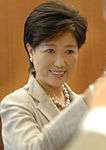 |
Yuriko Koike | July 4, 2007 | August 27, 2007 | 54 | |||
| 3 | 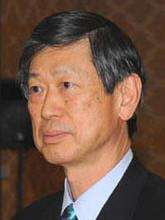 |
Masahiko Kōmura | August 27, 2007 | September 26, 2007 | 30 | |||
| 4 |  |
Shigeru Ishiba | September 26, 2007 | August 2, 2008 | 311 | Yasuo Fukuda | ||
| 5 | 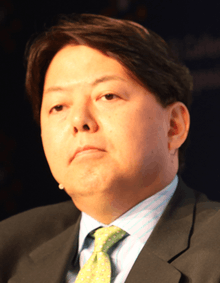 |
Yoshimasa Hayashi | August 2, 2008 | September 24, 2008 | 53 | |||
| 6 | 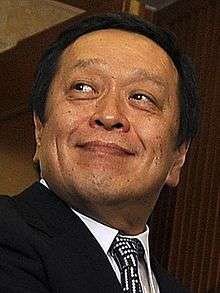 |
Yasukazu Hamada | September 24, 2008 | September 16, 2009 | 357 | Taro Aso | ||
| 7 | 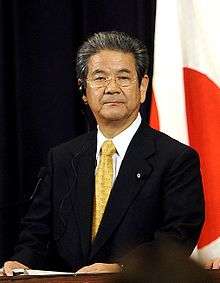 |
Toshimi Kitazawa | September 16, 2009 | September 2, 2011 | 716 | Yukio Hatoyama | ||
| Naoto Kan | ||||||||
| 8 | 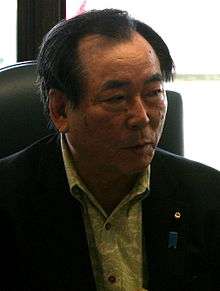 |
Yasuo Ichikawa | September 2, 2011 | January 13, 2012 | 133 | Yoshihiko Noda | ||
| 9 | 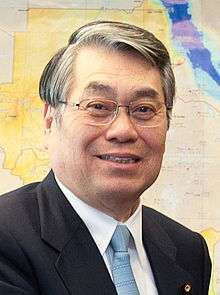 |
Naoki Tanaka | January 13, 2012 | June 4, 2012 | 143 | |||
| 10 |  |
Satoshi Morimoto | June 4, 2012 | December 26, 2012 | 205 | |||
| 11 | 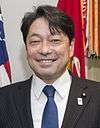 |
Itsunori Onodera | December 26, 2012 | September 3, 2014 | 616 | Shinzō Abe | ||
| 12 |  |
Akinori Eto | September 3, 2014 | December 24, 2014 | 112 | |||
| 13 | 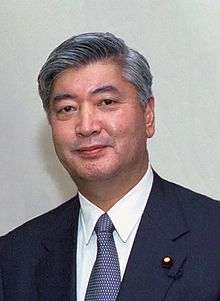 |
Gen Nakatani | December 24, 2014 | August 3, 2016 | 588 | |||
| 14 | _cropped.jpg) |
Tomomi Inada | August 3, 2016 | present | 135 | |||
References
Zhongguo, T. (27 December 2006) LexusNexis Academic, Japan’s upgrade of Defense Agency paves way to military power – HK-based agency. Retrieved 16 July 2010. “Library of Congress Country Studies”. JAPAN, The Defense Industry. . Retrieved 18 July 2010. Chinadaily.com.cn (10 January 2007) LexusNexus Academic, Defense Agency upgraded to Ministry. Retrieved 16 July 2010.
